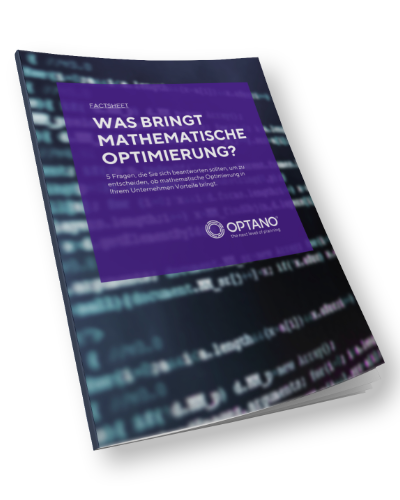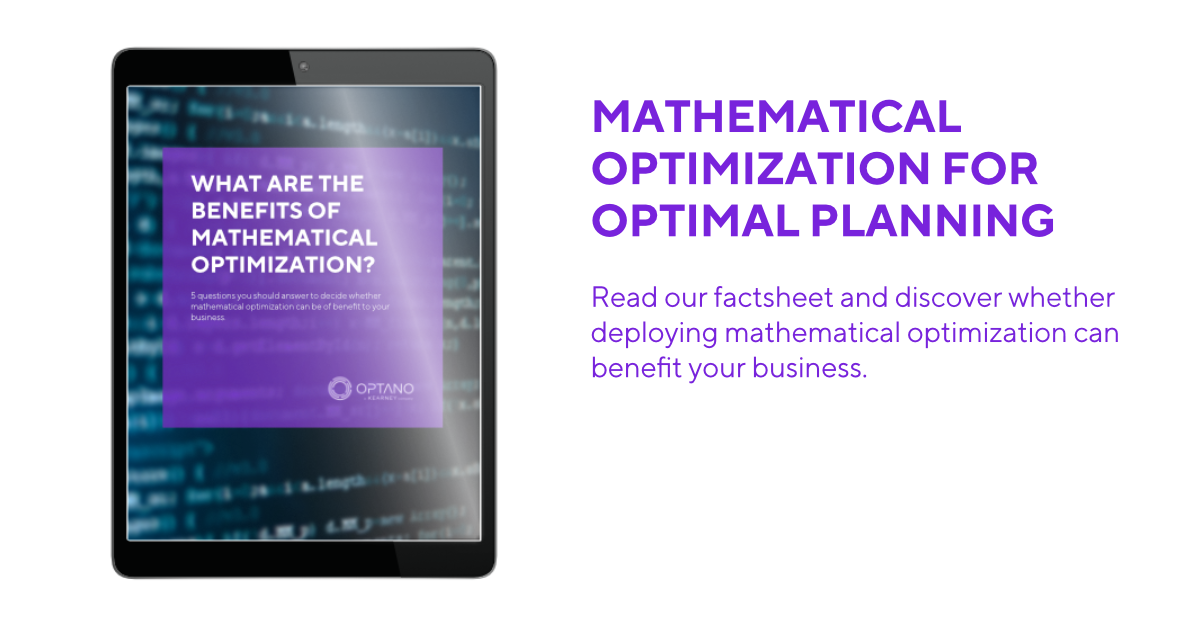A multi-tool for all optimization issues
“What is mathematical optimization?” This is a question that many of our software engineers and analysts have to answer whenever they are asked about their jobs. For those who used to dread math lessons at school and believed that basic arithmetic was enough to help them get along in life, these two words on their own – mathematical and optimization – will probably sound daunting enough. Combine the two and it will sound like one of those extremely complicated, exotic subjects which has absolutely no bearing on our daily lives. This assumption couldn’t be more wrong. In this article we want to explain how powerful mathematical optimization actually is and how it can benefit today’s business world more than ever…
What exactly is optimization?
The Collins Dictionary defines optimization as follows: “the fact of optimizing; making the best of anything”. In other words, when we optimize something, we are trying to make an item or situation as perfect as it can be and get the best result out of it. Optimization is made up of three essential elements:
- Variables: these are entities and parameters which can be changed constantly (e.g. operating parameters)
- Objectives: these are the goals you want to achieve (e.g. efficiency, high performance, etc.)
- Constraints: these are the standards, regulations and specifications that need to be met in any process (e.g. costs, deadlines)
We optimize on a day-to-day basis with these three elements in mind, often without even being aware of it. Let’s take a look at a very basic, everyday optimization problem: buying a car. You want to buy a car to get you to work as fast as possible or to go on holiday. Environmental friendliness is an important aspect for you at the same time! And of course, it has to be a car you can afford.
In this case, the parameters of the car are the variables – for example, there are different engines (electric, carbon, hybrid). How many seats it has, consumption, performance, insurance costs, tax and even the trunk may also be relevant factors. The constraint is the price of the car – in other words, you can only buy a car which you can afford.
The objective is that you want to get around easily, quickly and affordably while being environmentally friendly at the same time. By comparing all the options you need to consider, you will find the best solution. This is just one example of how we optimize on a daily basis. It’s not that difficult, is it?
So what is mathematical optimization?
Mathematical optimization is, of course, a far more sophisticated process than that of the example we have just mentioned above. It goes back more than 70 years and has made huge advances thanks to constant research and developments in Artificial Intelligence over the last few decades. Today, mathematical optimization is a powerful multi-tool which is applied in many areas of business and industry in order to solve far more complex problems than the mundane question of which car to buy. It is behind the success of many leading global companies in the fields of energy, telecommunications, logistics, finance and many more by giving them the means to make optimal decisions in order to achieve maximum efficiency and generate major cost savings and revenue growth. So, how does it work?

Are you interested in our factsheet
What are the benefits of mathematical optimization in business?
How mathematical optimization does its magic?
The power of mathematical optimization is demonstrated whenever processes are so immense and complex ,with many variables, constraints and cross-dependencies, that the human brain is incapable of solving them. Using highly sophisticated algorithms, it very quickly combs through millions and millions of possibilities until the right solution is found.
For the mathematical optimization application to work, two components are required: the solver and the optimization model. In the mathematical optimization application, the solver can be compared to a black box: it contains a collection of highly sophisticated algorithms which are able to sift through millions, billions, even trillions of possibilities. All the user has to do is insert the solver into the optimization application and it will analyze all the data at its disposal and come up with the right solution in a very short space of time.
The mathematical model is a highly customized, detailed replica of your company’s business problem, containing all the variables, constraints and objectives of your business. By defining your business problem in a mathematical model, the problem becomes quantifiable i.e. can be calculated in mathematical terms. Using the solver, it can come up with the right solution to your specific problem.
The power of mathematical optimization
For mathematical optimization to work effectively, it requires information with which it can work. This can be extracted from the wealth of data that has been accumulated on virtually all aspects of the company: historical data such as prices, sales, production, personnel, supply chains and so on. Based on the analysis of this data as well as the model of your business, mathematical optimization can find the right solutions to your real-world problem and enable you to make optimal decisions for the future.
Mathematical optimization – the planning tool of the future?
Events of the past few years have shaken the foundations of many businesses to the core: Brexit, natural catastrophes, and of course the COVID-19 pandemic have had a profound impact on the stability of many companies’ supply chains and manufacturing processes. This has led many to rethink the way they plan these and make better decisions in order to be well prepared for possible disruptions in the future Traditional methods such as Excel-based planning are no longer enough. According to Gartner, by the end of 2024, 75% of organizations will be using artificial intelligence techniques, including optimization, to improve their planning processes, predict future trends and identify risks. The more advanced form of analytics they deploy, the stronger their market position will be. The benefits of deploying mathematical optimization are surely evident. Even so, many companies are still hesitant to take this step into the unknown.
Are you unsure about whether mathematical optimization will benefit your business? If so, then consider the five questions below:
- Are you unsure about wheDo you frequently have to revise your plans during a running process?
- Does your business have a lot of cross-dependencies?
- Are you optimizing one or more goals?
- Do you believe it is important for you to know how good your plans are?
- Do you often have to plan under uncertainty?ther mathematical optimization will benefit your business?
More interesting articles
So what is our conclusion?
If you answered one or more of the above questions with “yes”, then it is time to seriously consider deploying mathematical optimization in your company. An optimization platform such as OPTANO deploys mathematical optimization. In this way, you have a sound basis on which to make decisions and find optimal solutions for your planning challenges. Whether it’s in production planning, supply chain management, deployment and route planning and many other areasm OPTANO makes your planning processes efficient, fast and flexible.
In our factsheet What are the Benefits of Mathematical Optimization?, we explain in depth how mathematical optimization works and how it can benefit your business. If you would like more information on how OPTANO can enhance your planning or if you have any other questions about this topic, then do not hesitate to contact us. Dr. Sven Flake is happy to answer your questions on mathematical optimization. Or you can e-mail us and we will contact you in due course.
Do you already know our Factsheet on the topic?

In our factsheet “What are the benefits of mathematical optimization?” we ask 5 questions to help you assess whether mathematical optimization brings benefits to your organization.
To obtain our factsheet, all you need to do is enter your contact details in the space below. A pop-up window will then open to download the whitepaper. Please note that by providing us with your email address, you agree that we may contact you on this topic. You may revoke this agreement at any time by contacting [email protected].







